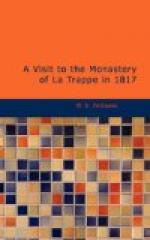From all this there resulted, as Madame de L. assures us, a certain innocence and kindliness of character, joined with great hardihood and gaiety,—which reminds us of Henry IV. and his Bearnois,—and carries with it, perhaps on account of that association, an idea of something more chivalrous and romantic—more honest and unsophisticated, than any thing we expect to meet with in this modern world of artifice and derision. There was great purity of morals accordingly, Mad. de L. informs us, and general cheerfulness and content in all this district;—crimes were never heard of, and lawsuits almost unknown. Though not very well educated, the population was exceedingly devout;—though theirs was a kind of superstitious and traditional devotion, it must he owned, rather than an enlightened or rational faith. They had the greatest veneration for crucifixes and images of their saints, and had no idea of any duty more imperious than that of attending on all the solemnities of religion. They were singularly attached also to their cures, who were almost all born and bred in the country, spoke their patois, and shared in all their pastimes and occupations. When a hunting-match was to take place, the clergyman announced it from the pulpit after prayers,—and then took his fowling-piece, and accompanied his congregation to the thicket. It was on behalf of these cures, in fact, that the first disturbances were excited.—Edin. Rev. for Feb. 1816.]
This luxuriance of growth does not proceed entirely from the moisture supplied by the ditches and drains; the soil naturally is uncommonly fertile: and whatever springs from it, whether planted by the hand of man, and nourished, while growing, by his attention and skill, or its spontaneous production, bears witness to this uncommon fertility. The country abounds in corn and vineyards; the produce of the latter consists principally in white vines. At the season of the year when I passed through it, the intermixture of the rich and soft yellow of the wheat nearly ripe, with the light green foliage of the vines, produced a most pleasing effect. In Poitou and Anjou, the harvest generally begins about the latter end of June: this year it was late every where, but very abundant. The vineyards had mostly failed.




